“An army marches on its stomach”Napoleon
The military is responsible for many advances in food technology: it was Napoleon that put out the call to invent a method of canning. French chef Alexis Soyer created the Soyer oven for British troops during the Victorian era, which lasted from the Crimean war until the Falklands war in the 1980s.
I spent 24 hours at the Prince William of Gloucester barracks near Grantham, Lincolnshire, shown around by Warrant Officer I Sam Barton and Lieutenant Colonel Jane Cattermull. This unit of Reserve chefs are the 167 Catering Support Regiment.
There has been much change in the British military over the past few years. Government desire to reduce the defence budget, and public revulsion at casualties of warfare, most notably those arriving at Brize Norton, has led to streamlining. Since 2015, the regular army and the reserve army are being brought closer together, a project called Army 2020 Refine, which seeks to modernise army structure and of course, save money.
In terms of numbers, 78,000 soldier are regulars and 25,000 are reservists. Chefs are always needed: about a 1000 are regular, and 800 are reservists.
I joined one of 167’s 16 day military catering courses, on the 13th day. I was shown around an OFCS, a field kitchen that will feed 40 people. It consists of 1 full size and a 1/2 size hot plate, a water boiler that can be used as a shallow fryer, and a couple of steel tables. There is an oven (in a kind of trunk). Above you can see the simple temperature dial which has a range of temperatures from cold to warm to hot to very hot.
‘We ask people to make sure the oven is between 10 o’clock and 2 o’clock’
The equivalent of between 180c and 200c.
The trainees had built stoves from metal dustbins, which they plastered with mud, making a tandoori style makeshift oven.
‘We’ve had filing cabinets used as well. They light a fire in the bottom drawer, then put the food in the upper drawers.’ said one soldier-chef.
‘Imagine you’ve lost your equipment. Set ups like this were popular in Afghanistan.’ explained Sam.
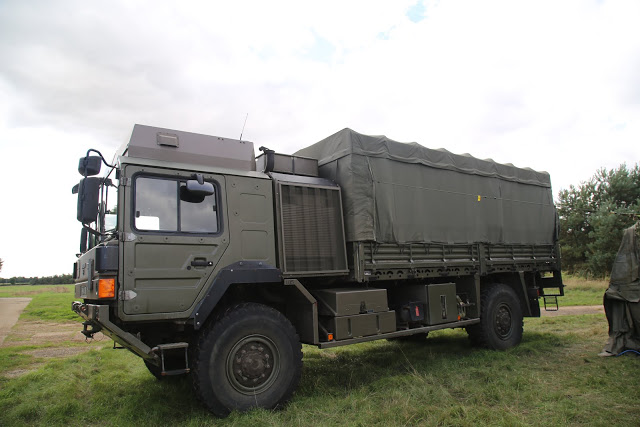
An OFCS unit will be transported by an enormous truck weighing 6 tons or 9 tons. Each piece of equipment is incredibly heavy, from 50 to 88 kilos, from a ‘2 man carry’ to a ’16 man carry’. The soldiers still have to carry it from the truck to the field kitchen.
‘We just have to manage’ said one.
In a large base camp, they will have 1000 OFCS units to cater for the troops.
Today’s menu was chicken, ham and egg, braised rice, onion bhajis and vegetable curry in cabbage parcels. There is always a vegetarian option. I was invited to share lunch with the soldiers in the field tent. Plates are throwaway paper, and cutlery is plastic.
‘We used to have billy cans and metal cutlery. But billy cans add to the weight of your backpack and clatter around. Today billy cans and metal cutlery aren’t considered hygienic enough for the modern soldier. Sometimes you have no water to clean them’
I was instructed to wash my hands before eating. Hygiene is incredibly important as is food safety. The last thing you want, I imagine, is a regiment of food poisoned soldiers in battle. However when looking at the ration packs, it was explained that much of the food is designed to ‘bung you up’.
‘In Jordan, when they built the dining room out there, it wasn’t to British standards, the sewage pipe spewed into the dining room. It stunk. Soldiers had to eat out of foil packets for several days.’
Ration boxes are usually for 10 men for 24 hours: breakfast, dinner, snacks and drinks. The box costs £35, therefore each soldier costs £3.50p per person per 24 hours. Each portion for an individual meal is about 300g. Sixty per cent of the budget is for the ration pack, and 40% is for supplements, such as bread or fruit from the local area.
‘If we have people who have special dietary needs, we’ll have a supplement to buy special ingredients for them, say gluten-free flour.’
‘Each ration pack is calculated in terms of nutritional value for soldiers. ‘
I suppose soldiers need more protein, a different requirement from civilians, as they are using up a lot of energy?
‘Usually they have 3.5k to 4k calories for operations. They need dense protein and carbs. These rations are designed to give you 3k calories per man.’
‘Marines need more calories, because of their activities, being at sea. Those who run the guns, they burn up loads. And they eat more fish’.
And the RAF?
‘Raf get luxury hotels. They are a little bit pampered, compared to the rest of the army where they just have to dig a hole and live in a trench. But they have a longer career. We have a shorter career.’
Do you have a problem with soldiers becoming overweight or are they so active that doesn’t happen?
‘At home bases, a lot of the barracks, contractors provide the feeding, so there are more fast food options and retail options which are more expensive.
Up until 10 years ago, soldiers meals and accommodation came directly out of their pay.
That money would come to the army. Now the soldiers do pay as you go- there is a till at the end of the hot plate.’
‘Today we’ve less control over the diets of soldiers, so there are overweight soldiers. Fitness is an issue.’
I’m later told that in barracks they must work out at least three times a week.
‘We have to educate soldiers on nutritional and healthy eating.
A lot of garrisons have fast food areas, McDonalds etc. ‘
I taste the chocolate biscuits. They are very dense but aren’t bad at all.
‘They don’t melt. You can’t take chocolate to the Middle East.’
In fact much of the food is in tins. A ration box last up to three years. Margarine replaces butter, as it lasts longer in a hot climate. Cheese comes in a tin, it’s so compact that it needs to be warmed and diluted to be used as a cheese sauce.
‘Tea is essential.’
Are you finding with younger soldiers they aren’t drinking tea anymore?
‘Yes they are. You’ve got coffee there as well. But you’ve got 40 tea bags and 10 men…. so you use each one more than once, otherwise you only get 4 cups of tea in 24 hours.’
‘Every squaddie they get one slice each of spam. You want to get 10 slices out of the 2 tins. We use the oil from the tins for frying.’
Everything is in really strong packaging!
‘It has to be, if you are dropping it from a helicopter. In Northern Ireland, you could never land a helicopter, cos the IRA would get you, so they’d just hover over the camp and drop it.’
‘There are hi-energy drinks, with electrolytes. Porridge oats is still so popular, it’s come back. over the last 10 years its suddenly taken off again. Squaddies are really into porridge.’
I’m shown a meal plan:
‘This is a typical menu. a guideline what you can produce. this is menu A. that’s what you get in that box and then what you can make. These are the different menus… five boxes.
‘There are a lot of innovative ideas that people come up with, that’s why we have annual competitions, such as Army sustainer. The chefs will be given mystery ration boxes. They have 2 and a half hours from breaking soil to make an oven to coming up with a meal. They have to forage food, use pigeons, whole salmons. they have to produce 20 portions and 2 courses. It takes place on May 18th next year’.
Women soldiers have exactly the same rations?
‘They do the same work. They are soldiers. Women soldiers carry the same weight – 50 kilos.’
You can carry 50 kilos?
‘Yeah. I can carry 200’, replies Sam nonchalantly.
In that programme ‘Our Girl’, do you think she’s carrying that?
A chorus of laughs and disapproval:
‘That’s rubbish.’
‘I think her pack is full of make-up.’
‘Who ever wrote that programme needs a kick in the…’
Could that programme attract some girls? or boys who might think that they’ll meet women who look like that?
‘It gives a wrong impression.’ They shake their heads.
‘The first series wasn’t bad, but after that… she’s wearing false eyelashes!’
In ‘Our girl’, men and women sleep in the same barracks. Is that real?
‘Yeah. We are sleeping in this catering tent tonight, mixed sleeping.’
‘It’s about the only accurate thing. you just muck in.’
‘I think that’s something quite unique with the chefs department.’ explains Sam.’ We are all so close, males and females.’
I have a look at the ration pack labelled V, for vegetarian. I see there is hazelnut spread, hot sauce, cheddar cheese spread, fruit purees, boiled sweets, chewing gum. There are also diabetic packs, kosher ‘it’s clean’, and Hindu for Gurkhas and Sikhs.
‘There is like a feedback sheet. They are constantly developing these packs.’
And if you were vegan?
‘No there’s not a vegan one yet. it’s something they are looking into.’
Have you ever met vegan soldiers?
‘Yes, two courses ago. A male. We had a woman who was an absolute vegan, she produced amazing food for vegans. A good little chef with lots of patience.’
‘Sometimes they are on a fad- two weeks later you see them eat chicken.’ remarked another soldier.
In each pack there are napkins.
‘For personal hygiene.’
‘Toilet roll.’
‘It’s either that or a leaf.’
‘As we said, some of these foods are designed to clog you up. They’ll bung you up for 24 hours. There is a biscuit called biscuit browns, you’d eat them and they’d just clog you up.’
‘People don’t think about these things. We’ve got to think about dietary fibre. If you haven’t gone for 48 hours, you are gonna know about it when you go.’
‘If you are in battle, your body shuts down to a certain degree…’
I’d think you’d literally shit yourself.
‘People don’t talk about it but it has to be considered, it’s not something we talk about with the soldiers during training.’
I imagine that moment when you are pushed out of the tank, or helicopter, it must be…woah
‘That’s why you are trained…’
Can you ever get used to that?
‘That training kicks in. You don’t even think about being scared, you just react. Most of us have a physical reaction. Fight or flight mode. And there’s nowhere to flight to.’
If you were now in Afghanistan you would take enough rations for the days the mission will last?
‘Normally 48 hours worth. If you are going out on a mission into Afghanistan, you get 12 hour ration pack of grab and go self- heating foil packets.’
Food is a way of creating bonds…
‘When I was in Afghanistan, we were attached to the Afghan unit, we used to eat with them. They’d make their meals, they’d sit on the floor, and they’d invite us. We’d sit down with our guns on our back. We did that twice a week and we’d invite them back. Catering is very social.’
Working in all these countries, you also find out about their food?
‘Yes and we work with the French, the Americans, the Danish…’
Are the French army cooks very good?
‘They’ve got a bigger budget than us but they are very ‘take it or leave it’, there is no choice.
The French attachment are used to having wine in their rations. They weren’t impressed with our meals, they normally have five courses.
With the Americans, we’ve used their kitchens, it’s a completely different set up: they have 2 meals a day, they don’t make stuff from scratch, meals are bought in and heated up. Americans used a system, where they all had the same meal, all around the world.’
On recruitment:
‘At the moment we are low in numbers. There hasn’t been a war for a few years.
Wars keep people in the army. When a war is going on people are more motivated.’
‘Otherwise people leave. For younger soldiers, if nothing is going on, they leave.’
‘If you are in a barracks, you are training for deployment.’
‘You’ve got this standing army who are quite pleased when they are sent off.’
‘I want to go out, I don’t want to be in camp.’
How many months can you stand in camp?
He shrugged.
At the barracks and in many places today, civilian contractors provide the catering. Military chefs are only used on deployment in the field.
Does a chef in the army still have to train as a soldier?
‘Definitely.’
Are you in danger?
‘Yes. Chefs deploy forward with the troops. We have chefs going out on patrol with the soldiers.’
You have to carry a gun… and a cooking pot.
‘If you are deployed in tactical situations, chefs have a gun. In one situation, I had to cook in full body armour.’
You are joking.
‘Yeah… and there was mortar fire.’
‘We have secondary duties, you may go out on patrol, you might be on guard, you might be doing Sangar– watch tower duty. I’ll do triage as a medic too.’
How many are cooks in real life? Have they thought of this path before they’ve joined up?
‘In 167 regiment about 20% are already chefs.’
One Scottish soldier said: ‘I used to work a 4 star fish restaurant, I worked there for 5 years. One day I finished an early shift, seen one of my friends in the street, said he was going to an army recruitment office and asked if I wanted to accompany him. I got talked into it. They talked me into it. They said I ‘d be waking up every day with a bacon sandwich. ‘
Everybody laughs.
‘… and when they found out I was a chef anyway’
Many of the places you go to are very hot? Is it hard to function within a kitchen?
‘It’s hot and humid, but wherever you are deployed, say the Middle East, your body tends to adjust to it within about a week. You are on your feet constantly 16 hours a day.’
‘Three years ago I was in 45c heat for weeks. you just get used to it.’
I look at the training manual, the Reserve chefs army recipe book.
‘The book is given to all the classes and they take it with them. They can make their own notes.’
So they can tweak them. Four portions? Quite small recipes so they scale it up?
‘Yes, that doesn’t work perfectly but it gives them an indication. We used to have a recipe book that went up to 1500 portions.’
Seriously people are making their own puff pastry? In the field?
(Laughs) ‘They insist it’s learnt, it’s a skill. If you can make puff pastry, you can make rough puff, pies etc with the packet of flour in the ration pack. ‘
It’s interesting because a classical French kitchen is based on army hierarchy: yes chef, yes sir.
‘Yes it’s a brigade of chefs’
I continue to flick through.
I bet pizza goes well?
‘Yes, for today’s generation, and they want wraps.’
Get many requests for courgetti? I joke.
Recruitment:
Why become an army chef? What are the advantages of working in the chefs corps?
‘The promotion rate is quite good. There is always perks, free food. The guys are getting smashed on patrols, but we have always got food and heating in cold climates.’
‘You get qualifications, nvq’s.’
‘ Everybody wants to be a chef’s best friend when we are on exercise.’
‘We are not as respected as we’d like to be in barracks but we are very popular when deployed.’
‘We’ve got the power to charge their phones’ grins one soldier.
‘Navy can’t recruit. It’s an issue across the whole of defence, especially chefs. It’ll get worse after Brexit.’
Why?
‘A lot of chefs are from overseas, they might leave. Also they’ll have the opportunity to get jobs outside.’
‘When there is unemployment it’s easier to recruit.’
‘There are lots of posts empty on civvy st.’
Why be an army chef rather than another trade?
‘As regular chefs within the army, you are attached to different regiments for 3 or 4 years. But if you join a regiment as a soldier in the regular army, you stay with them for 22 years. As a chef, you get to see different parts of the army, they’ve all got different styles of what they expect to eat.’
If you join as a chef, can you then train in a different area?
‘Yes. I joined at 17, on a bit of a rogue path’ Sam smiles wryly,’ and the army gave me discipline. I’ve got a lot of transferable skills in our trade. I’ve got qualifications now. When you do come to the end of your career, you can train in whatever area you want. You can do resettlement courses.’
You’ve got 6 more years, any idea of what you want to do?
‘Not really. I’ll be 42 when I get out.’
You’ll still be quite young you can do another whole career.
‘As a corporal you are in charge of a kitchen. I’ve been out of the kitchens for half my career now. There is probably some skill fade. I don’t think I’d want to go back into the trade. I have more skills as a manager now. I think I’d go in a completely different direction. Maybe just be a mum for a bit. My daughter will be 8 when I leave.’
Why do you join the army?
Sam: ‘Everybody has got their own personal reasons. I left school at 16, no qualifications, I came from a bad area, no employment.
I wanted to be a soldier, I wanted to run around with a weapon. I saw the Falklands that interested me. I chose my trade. I did my training at the catering college at Aldershot, then the passion took hold for me.’
Is it good wages?
‘I enjoy the lifestyle, I enjoy moving around, housing is subsidised, your medical is subsidised. You’ve got a pension from the age of 40 or 42.’
You’ve got a partner and 2 kids, is he in the army?
‘Yes he was. That was another draw for me- my son’s in boarding school because I’m always moving around and the army pay 90% of that. There are a lot of perks but you spend a lot of time separate from your partner. You can put in preferences of where you’d like to be, and if anything is available you get that.’
How long have you been here?
‘Just over a year and in Catterick garrison in Yorkshire before that.’
So your partner has to move with you, and he had to find a job around here.
‘Yes. He works for open reach, not too hard. But for others it’s difficult.’
Another soldier joins in: ‘That’s what gets to me, the constant uprooting of the kids education. My kid was in Germany, then she had to change system to the Scottish system, then back to England. Very hard.’
Sam: ‘We put our son in boarding school at ten. We had no choice because by then he’d been in six schools. He had to keep changing friends.’
‘The best thing in the army, you’ve got that security. If you do fuck up you get a blocking, if you fuck up in civvy st you get sacked.’
‘Cheffing is an unsociable trade. You get paid extra in the army. In civvy st there is no incentive. It’s not compatible with family life. It’s a single man’s job, or single woman’s job.’
Someone points to this soldier, teasing: ‘He’s on his 4th wife!’
Sam: ‘I was ok with my first husband, I served with him in the same regiment, But he’d go on tour, then I’d be posted. We saw each other every couple of months. You are expected to put the job first.
The teams with which you work, the experiences and the relationships, that’s where you get your satisfaction from, the camaraderie.’
What are your hours?
‘We wake at 5 am, wash, shower.
Prepare Breakfast for 7.30amDinner for 5.30pm.
In bed by 10pm.’
The trainee chefs work their way through each module: patisserie, butchery, six month turns. As soon as they get through the units, they can choose what they want to do.
If you had a vegetarian or vegan chef, and they were deployed, they’d have to cook meat as well?
‘Yes, they’d have to turn their hand to all of it. We had one who was crying when cutting up a lamb.’
‘When you are professionally trained, you’ve got to be professional.’
‘In civilian street, you can specialise. As an army chef, you’ve got to turn your hand to whatever.’
Food is so important for soldiers under stress, missing home.
There is quite a lot of jargon involved with any world, and the military world is no exception. The army is a microcosm of the real world. Virtually every part of the outside world has its equivalent in the military. Here is a lexicon (which I had to rapidly get my brain around in order to understand what people were saying).
The military is divided into army, navy and air force.
Reserve army: formerly known, prior to 2014, as the Territorial Army. Part-time soldiers. You must put in at least 19 days a year. You get training. Apparently you get loads of money for this, holiday pay, and a pension.
Regular army: full time soldier. When you leave the army, you are automatically a reservist for the first 5 years, meaning you can be called up at anytime.
Brigade: from 1000 to 5000 soldiers
Battalion: 800 soldiers
Royal Logistic Corps: provides all the support services, of which the Army Catering Corps is one element.
Civilian Street or civvy st: Civilian life.
Demobbed: short for ‘demobilisation’. Leaving the military.
Cavalry: soldiers on horses.
Infantry: troops on foot.
Officers: if you are clever you can become an officer. A non commissioned officer can rise through the ranks. But a commissioned officer will go to military college like Sandhurst after university and do a year training course. But only 10% are women.
Deployment: going on missions, often abroad.


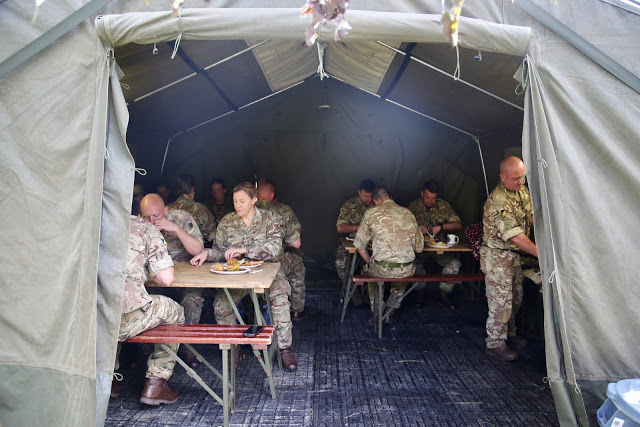


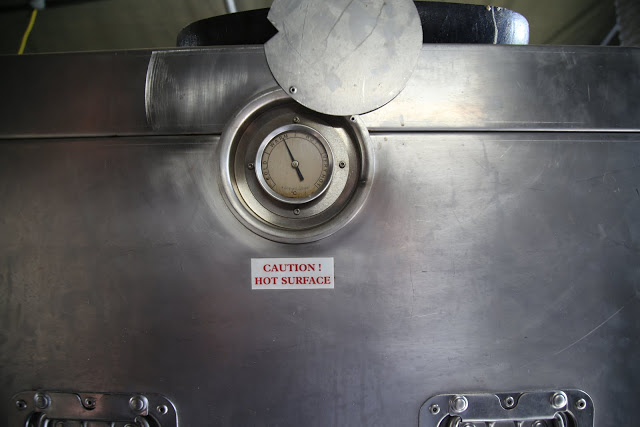
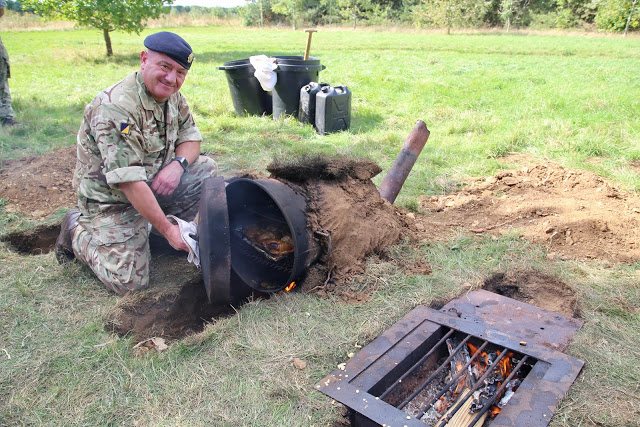

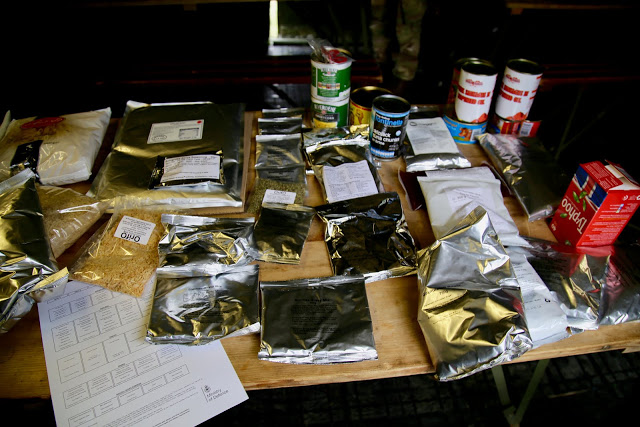
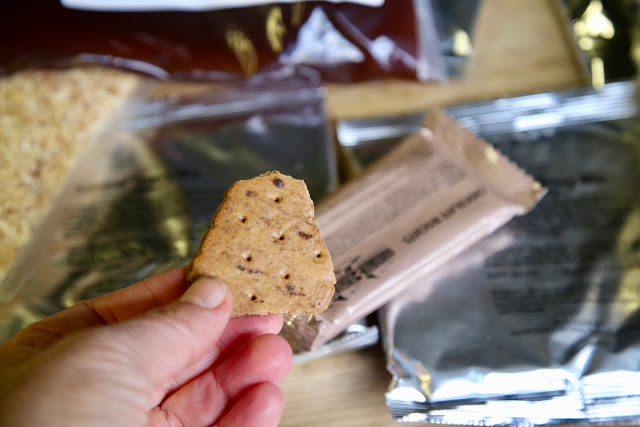

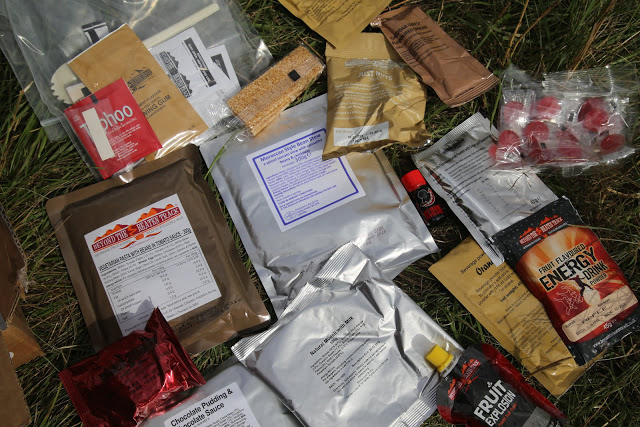
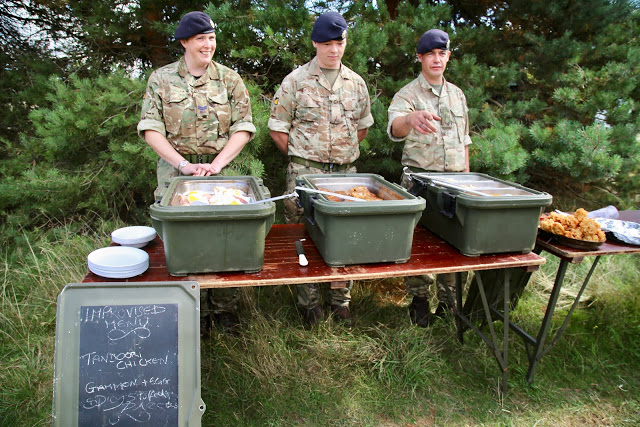
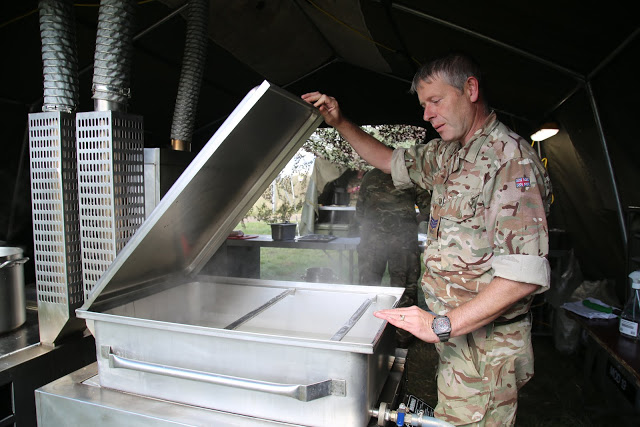
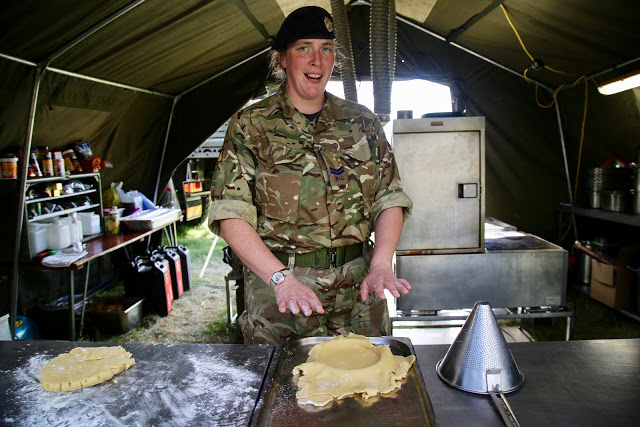
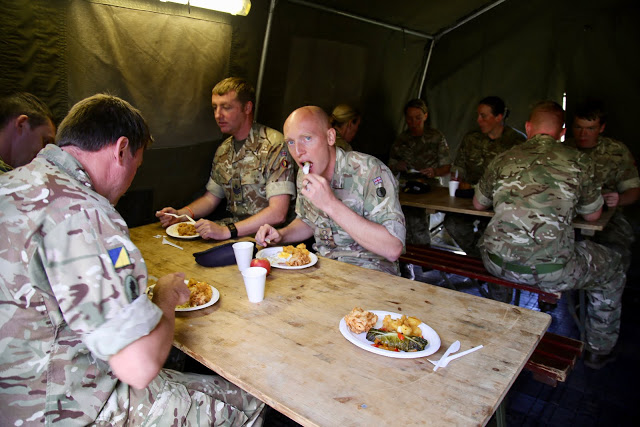
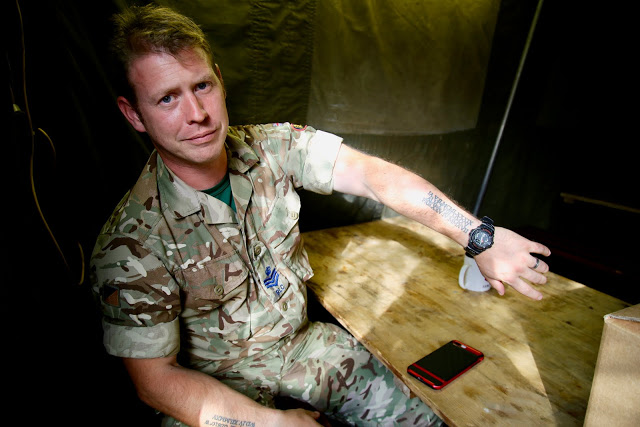
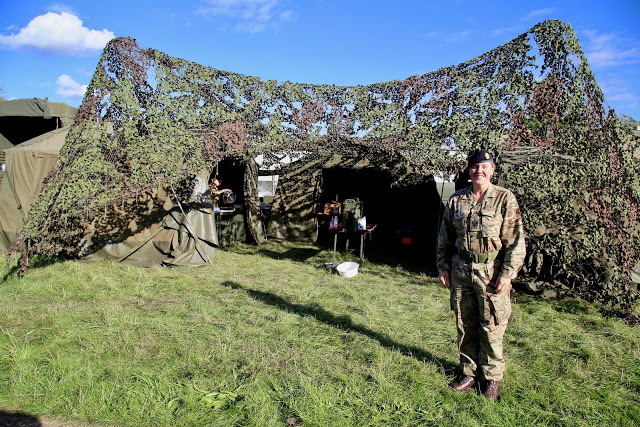
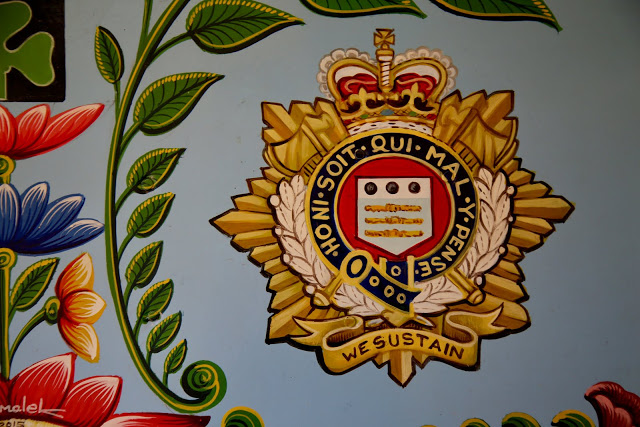



Love the story, only a real soldiers can tell a real soliders stories. Not the Hollywood glamour you expect
Love this article, well written and great insight into being a chef in the British army. Would you mind share our new website http://www.Britisharmychef.com – it’s aim is to help recruit regular and reserve chefs for the British army.